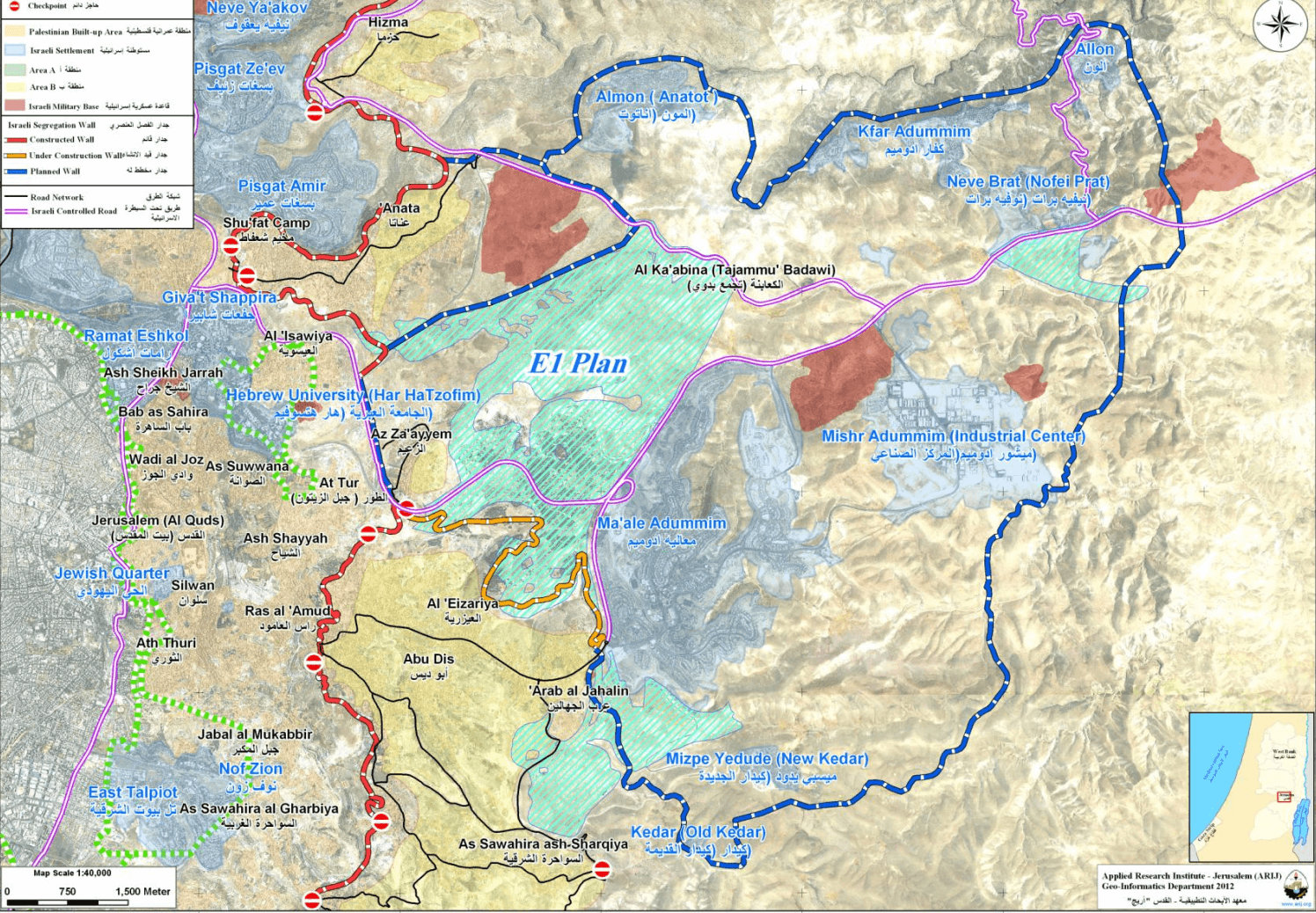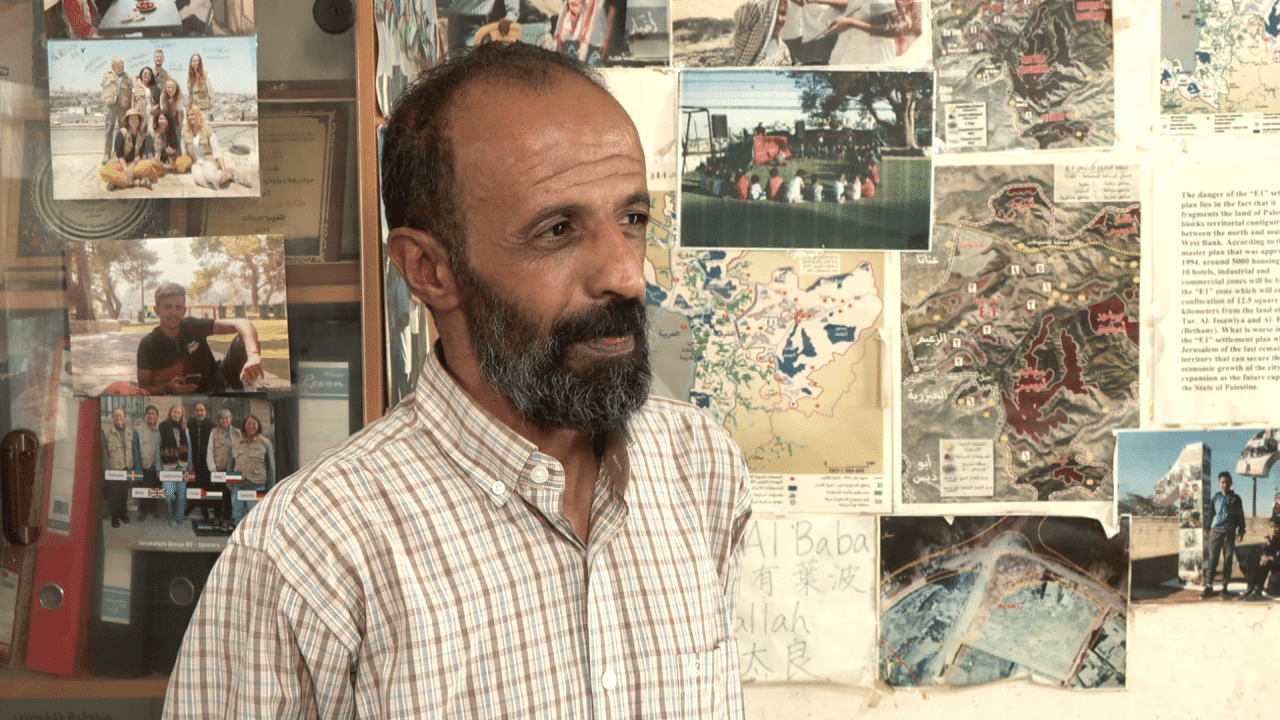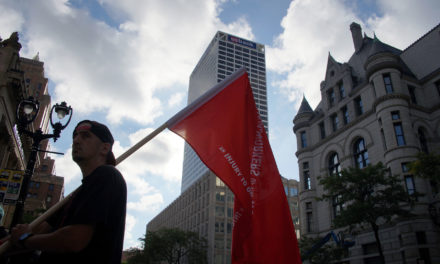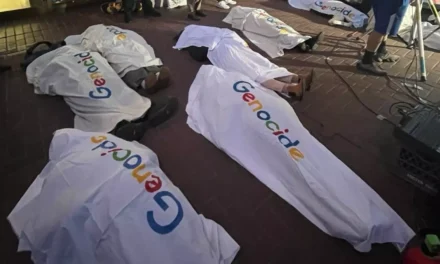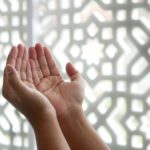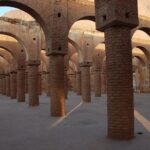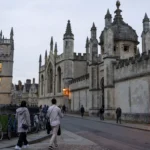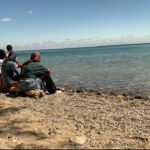Jabal al-Baba. (Photo: Zena al-Tahhan)
As a number of Western nations announce their recognition of a Palestinian state ahead of an upcoming UN General Assembly vote on the matter, Israel is accelerating its illegal annexation measures of the occupied West Bank to render a Palestinian state impossible.
Perched along ancient trade routes connecting urban Jerusalem to the desert of Jericho, the small Bedouin village of Jabal al-Baba is one of dozens of Palestinian communities facing imminent forcible transfer by the Israeli occupation.
The plan to expel these Palestinian communities is the linchpin in Israel’s plan to revive the long-halted E1 settlement plan, which had received international backlash for decades due to its far-reaching ramifications.
The area that Israel wants to pack with illegal settlers and render off-limits to Palestinians is a strategic tract of land that serves as one of the few remaining links between the northern and southern West Bank, and one of the last points of contiguity between occupied Jerusalem and the territory.
Once implemented, the plan would bisect the occupied West Bank in half and further consolidate Jerusalem into Israeli hands.
“This will bury the idea of a Palestinian state,” Israel’s Finance Minister, Bezalel Smotrich, proudly declared in mid-August, when the E1 plan was first revived. The minister, who oversees the demolition of Palestinian homes and the expansion of illegal settlements, announced on August 14 the approval of thousands of new apartments for illegal settlers in the area.
A map showing Israel’s ‘E1’ plan (Source: ARIJ)
Jabal al-Baba is home to some 450 residents who were expelled from their ancestral lands in the Naqab (Negev) desert during the 1948 Nakba — the violent ethnic cleansing of Palestine by Zionist militias.
Drawn to the semi-arid, open landscape that echoed the familiar terrain of the Naqab, they began anew on the eastern slopes of Jerusalem, ideal for their generations-old Bedouin way of life.
Now, 77 years later, they face expulsion once again.
“We are talking about the takeover of 12,000 dunams of land (12 square kilometers),” Jabal al-Baba spokesperson Atallah Mazaar’a told Mondoweiss. “Some 22 Palestinian Bedouin villages, home to at least 7,000 residents, will be expelled.”
“There is an attack on all Palestinian land from the north to the south, and particularly on Bedouins living in open, remote areas,” Mazaar’a continued. “The current seizure of Palestinian land is massive.”
Palestinian Bedouins living in the area earmarked for E1 are being progressively expelled, as Israeli authorities demolish their homes, evict them from the land, and install Israeli settlers in their place. “E1 is the most problematic project with regard to the Palestinians of Jerusalem,” Mazaar’a said. “Israel knows how important it is. That’s why it is racing to implement the settlement plan.”
Despite facing imminent expulsion, Mazaar’a says the village will remain steadfast. “We would rather die as honorable people on our lands than hand it over to settlers and occupiers,” he affirmed.
‘Expulsion upon expulsion’
Between August 12 and 15, Israeli occupation forces delivered some 40 demolition orders to homes across Jabal al-Baba and two other Bedouin villages nearby, giving them 60 days to appeal.
But these are not the first. Israel’s E1 settlement project has been in the pipeline since the early 1990s, first proposed under former prime minister Yitzhak Rabin. The plan entails the construction of thousands of illegal settler housing and commercial units to create a continuous built-up area between the Ma’ale Adumim settlement, where some 70,000 Israelis live, and Jerusalem.
Since 2009, the Israeli occupation has demolished more than 500 Palestinian homes and other livelihood structures across dozens of communities in the E1 area, including close to 200 funded by international donors like the European Union. At least 900 people were forcibly displaced.
In 2025 alone, the military has already torn down at least nine homes and over 50 animal shelters.
“This is expulsion upon expulsion,” Bassam Bahar, head of the committee to protect eastern Jerusalem’s lands, told Mondoweiss. “These families have been here since the 50s, and they are living on private Palestinian lands with the approval of the owners.”
“Israeli occupation authorities want to transfer these residents to the population centers of Abu Dis and possibly even Jericho, to create a new demographic reality in the eastern areas of Jerusalem – the only area left for Palestinians in Jerusalem to expand,” he continued.
“The goal of all these projects is to Judaize Jerusalem and to create a settlement belt around Jerusalem to surround it from all sides, whether the north, south, or east,” Bahar explained. “They’ve taken up all the areas in the south towards Bethlehem, and from the north towards Ramallah. Today, the only area they can further extend into is the east, towards Jericho.”
Ma’ale Adumim was built in 1975 on Palestinian land stolen primarily from the towns and villages of al-Aizariya, Abu Dis, al-Issawiyya, and Anata. These areas historically formed Jerusalem’s eastern suburbs, located just a few kilometers away from the city center.
After Israel occupied eastern Jerusalem and the entire West Bank in 1967, it redrew Jerusalem’s municipal boundaries, excluding these towns and placing them under military rule as part of the occupied West Bank. As a result, hundreds of thousands of Palestinians suddenly needed permits to access their own city. In 2002, Israel reinforced this separation by building its illegal eight-meter-high wall around these areas, isolating them — and nearby Bedouin communities — from Jerusalem to the west.
The E1 plan will make conditions even worse for Palestinians. First, Israel plans to build its wall around these areas from the east, completely encircling them. They won’t just be cut off from Jerusalem, but from the West Bank, too, and turned into an open-air prison.
Second, Israel recently approved the construction of a series of roads and underground tunnels — misleadingly referred to by Israel as the “Fabric of Life” or “Sovereignty” road — that will run underneath the heart of the E1 area.
This will divert Palestinian traffic away from the main highways going through E1 aboveground, in addition to the historic road to Jericho on Route 1 used by illegal settlers. Jabal al-Baba won’t just be cut off from Jerusalem; it will also be separated from the nearest town of al-Aizariya.

The “Sovereignty Road” that would isolate the communities of Wadi Jamal and Jabal al-Baba, between al-Aizariyah and Maale Adumim. (Map from Peace Now)
“The alternative route for Palestinians that they want to build is not fit for human use. More than a million Palestinians traveling between the center and the south will use it. It will be a danger to the lives of residents,” Mazaar’a of Jabal al-Baba said.
‘Emptying the land’
These developments come as part of Israel’s deepening annexation of the eastern areas of Jerusalem, as well as the entire occupied West Bank, in a bid to prevent the establishment of any kind of Palestinian state. Residents living in open areas are being forcibly transferred — a war crime under international law — as the Israeli military consolidates seizure of the largest Palestinian land mass possible.
Israeli authorities have been carrying out acts of annexation in the occupied West Bank for over five decades. But since the genocide in Gaza, the takeover of Palestinian land and the building of illegal settlements have hit record highs. The Israeli government is directly funding settlers with millions of dollars and arming them to push Palestinians off their lands.
Officials are no longer keeping it a secret. In July, Israeli lawmakers overwhelmingly voted in favor of imposing annexation on the occupied West Bank in a Knesset session.
On September 3, Israeli Finance Minister Bezalel Smotrich — who is also in charge of the demolition of Palestinian homes and construction of illegal settlements — unveiled a proposed map under which 82 percent of the occupied West Bank is rendered part of Israel. Three and a half million Palestinians are squeezed into a mere 18 percent of the occupied West Bank, making up the city centers.
“Maximum land, minimum population,” Smotrich said.
And with the recent announcements by several Western countries of Palestinian statehood, the aim and intent of annexation has become one of the most urgent goals for Israel, with politicians across the board calling on their leadership to take this action.
“They want to push people residing in remote areas and in the villages into the cities and besiege them there,” said Bahar. “It’s about emptying the land of its residents.”
Mazaar’a said residents are well aware that this is a deep-seated policy. “Israel is paying settlers to raid our villages. They come and take off their clothes in the center of our communities in order to provoke us to leave,” he said.
“Even if the entire world fails us, we as Palestinians will be the ones to push our cause forward,” he added.

